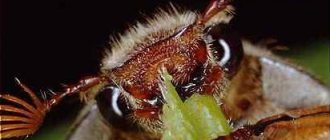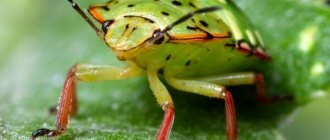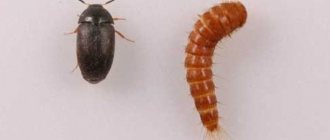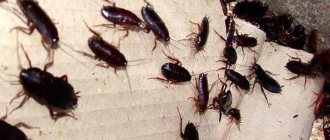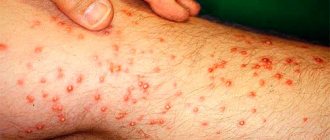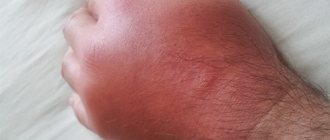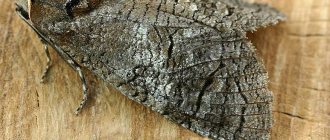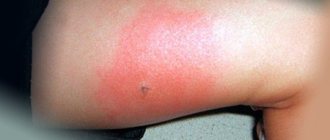What are the appearance features
In the photo, the blister beetle shows a bright color with a metallic tint. The head is narrowed, antennae are also located here, there are no wings, but there are flexible elytra, but they cover a small part of the chest. The total length of the body is two centimeters, it is elongated. In some species it can even drag along the ground. Main colors:
- bright red;
- yellow;
- green.
The appearance of different types of blister may differ. But the lifestyle is almost the same. These insects are parasites; females lay at least 10 thousand eggs during their lifetime. The main victims of blister are locusts and bees, so the expectant mother places the eggs closer to them in the soil.
The larvae appear after about three weeks, they are amber-yellow in color with three limbs, scientifically they are called triungulins. The larvae eat other insects, which they find using their sensitive sense of smell.
These beetles eat locusts
They can easily penetrate a beehive; several methods are used for this:
- in a flower, bees wait for the bee to land and then cling to it, flying away together;
- the second method is more interesting - triungulins create a living ball, clinging to each other, and secrete enzymes similar to bees. As a result, the male picks them up and carries them into the hive.
Inside they eat nectar, honey and bee larvae.
Lifestyle and reproduction
Adults of blister beetles are active from May to August. They live in large colonies and are often found on agricultural crops: potatoes, soybeans, alfalfa, melons. After mating, females lay eggs in damp soil. Spanks choose places where locust egg capsules are buried. Translucent oval eggs are laid in clusters. They mature in 2-3 weeks, then the larvae appear. At the first stage, these are campodeoid, mobile triungulins. Dark, with long legs and tail processes. There are long crescent-shaped mandibles. Triungulins are active predators and have well-developed sense organs. They crawl into the capsules (cocoons) of desert locusts, Siberian grasshoppers and Prussians and eat their eggs.
Inside the egg pods, the triungulin locust molts into a thick, white larva with short legs and body hairs. The free head has 3-segmented antennae and a mandible with two teeth. The abdomen consists of 10 segments. She feeds continuously, sheds 3 times and becomes fatter and clumsier. The older larva loses its hairs and the head becomes reddish. Having eaten all the eggs, she gnaws through the egg capsule. In the ground it turns into a false pupa. At this stage, it is motionless, the body is curved, and colored orange. In this state, the insect easily survives lack of moisture and other unfavorable conditions.
Information. The false pupa can remain in this state for up to two years, plunging into diapause.
After wintering, molting occurs, the larva becomes mobile and goes into the soil to create a pupal chamber. In the cradle it transforms into a white soft doll. The phase takes 2-3 weeks; the first adults appear in May. The complex process of development of red-headed blisters is called hypermetamorphosis. One generation develops per year; due to diapause, its development may take 2-3 years.
Pests or Helpers
The greatest damage to plants is caused by flocks of red-headed frogs in dry years, completely eating leaves, flowers and young twigs. At the same time, the blister larvae destroy the offspring of locusts, which eat all the plants within their reach. These beetles are of great benefit. It was noted that the massive appearance of locusts is associated with a previous increase in the number of locusts and locusts.
Information. Poisonous beetles are dangerous to cattle and other animals. When eaten together with grass, they cause serious poisoning.
Is a beetle useful or harmful?
Adult females and males do not harm the environment. They feed on green plants. The larvae are parasites and in some cases have a positive effect, for example, they destroy locusts and reduce the number of harmful crops. But at the same time they pose a threat to garden species: potatoes, cucumbers, cabbage, grains and others. They cause damage to beekeepers by eating honey and bee colonies.
The beetle contains toxins in the body and can cause intoxication; this is especially common in animals that decide to feast on the insect.
If qualified assistance is not provided in a timely manner, the dog or cat may die; kittens and puppies have much less chance of survival than adult pets.
In the past, blisters were used in pharmaceuticals for the preparation of certain drugs - diuretics and improving potency. But such drugs had a lot of side effects, negatively affecting the nervous system, the functioning of the kidneys and liver.
When bitten, beetles release a toxic substance
For humans, the insect bite itself is not dangerous, but the threat is caused by a substance - cantharidin, which the beetle secretes. It is poisonous and causes a burn on the skin, a blister or an abscess. Therefore, therapy with antihistamines and anti-inflammatory drugs is necessary.
Fighting methods
Blisters help control the number of locusts and Italian locusts. Usually the benefits of insects outweigh the possible harm. But in large quantities, the red-headed blister poses a danger to vegetable gardens and fields. To combat it, agrotechnical methods are used:
- autumn plowing;
- weed control.
On a personal plot, shpanok are manually collected and destroyed. The work is carried out early in the morning, always wearing gloves that protect the skin. In some cases, it is necessary to treat plants with insecticides.
What types of blisters are there?
There are a huge number of varieties of blisters, the most famous are:
- Quadruple.
- Saffron.
- Changeable.
- Dressy.
- Spotted.
- Cotton.
- Diverse.
The most famous is the Spanish fly or T-shirt.
One of the varieties is the Spanish fly
Blister beetle
Narynivnik
These are beneficial insects of large size and various bright colors. The basis of their diet is small insects, so blister beetles are a means of biological control of parasites and pests of agricultural plants. All members of the family prefer a warm climate; they are most widespread in countries with dry and hot weather.
The insect's body is quite fragile, so it can be easily damaged if handled ineptly or carelessly. The beetles themselves are not capable of biting a person, but the hemolymph, which replaces blood, contains the toxic substance contharidin.
When this liquid gets on open skin, it penetrates into the soft tissue through various microscopic cracks or damage, which causes the formation of:
- wounds;
- inflammation;
- abscesses or suppurations.
Note. Contharidin is a dangerous toxin. If it gets into the eye or mucous membranes, severe swelling or wounds will develop, which can cause serious health problems.
As a rule, the poison gets on the skin when a person tries to carelessly remove an insect from himself, while its delicate covers are torn and the hemolymph comes into contact with the epidermis. If the substance enters the intestines in large quantities, severe poisoning can occur or, in rare cases, death can occur, for example, if a person is severely weakened as a result of old age or a long-term illness.
Signs of poisoning are as follows:
- dizziness;
- nausea and vomiting;
- temperature increase;
- weakness.
The note. Ancient tribes used blister hemolymph for hunting, and a particular member of the family was often used in folk medicine. This species is commonly known as the Spanish fly.
How to deal with leaf beetles
To remove pests from a plot of land, folk remedies and professional preparations are used. To speed up the result, several methods are combined. The main enemy of humanity in the garden is the Colorado potato beetle. It destroys potatoes, eggplants, tomatoes, and less often attacks legumes. It can lay eggs anywhere, even on weeds.
Professional preparations
Insecticidal substances with contact-intestinal action will help exterminate a colony of pests in a day. However, the drugs have one significant drawback - they do not affect eggs. For this reason, the leaf beetle appears again, and the crop has to be processed again. This should be done after 14-20 days. During this time, a new generation of pests appears, and the effect of the drug after the previous spraying weakens.
Repeated processing of crops will destroy surviving adults and larvae that have not yet become sexually mature. But that’s not all. After 20 days, the leaf beetles should be poisoned again, since they can fly in or crawl from neighboring areas.
Beetle control products
Effective preparations for leaf beetles:
- Karate;
- Aktara;
- Confidor;
- Sherpa;
- Bankol;
- Actellik.
Dissolve in cold water according to instructions
During work, you need to take precautions, use rubber gloves and a respirator. It is prohibited to treat plants during the flowering period, 20 days before harvesting.
Folk remedies
Less efficient, more labor-intensive, but environmentally friendly.
- Ash and tobacco repels pests. Irritates the skin on contact, causes muscle spasms if ingested. Mix tobacco dust and ash in equal proportions, add water, and add soap. The last ingredient is needed to ensure that the powder remains on the leaves longer. Spray the plants, especially from the underside. Scatter dry powder over the area.
- Dissolve 500 ml of vinegar or a bottle of ammonia in a bucket of water. Pour the solution into a spray bottle or watering can and treat the culture. It is allowed to spray again with vinegar after 3 days, with alcohol - after 2 weeks.
In parallel with folk remedies, herbal remedies are used. The effect can be noticed after a week; be sure to repeat the treatment every 7 days until the pests completely disappear. One of the most common products is Fitoverm. You can buy it in a specialized store or hardware department.
T-shirt black (video)
In the Wikipedia article about the Mike Beetle mentioned at the very beginning, there is a reference to the documentary film “Venom. Achieving Evolution" (dir. Park Sunwoon, Republic of Korea, 2015). In the 3rd episode “The Poisonous War of Plants and Animals” of this film, several minutes (29:18-34:40) are devoted to the peculiarities of life (discussed above) of adult beetles and their larvae. I specifically indicated the timing, the full version of the film is on YouTube, it is easy to find through the internal search of the video service by typing in the search bar: Poison Achieving Evolution Episode 3.
I was lucky to find on YouTube some fragments from this film, specifically about an ordinary T-shirt, so it would be wrong not to add them here. The first fragment is about adult beetles, the second is about larvae. Screenshots were taken from these fragments to illustrate the point about the twists of evolution. The rest of the photos in the article are my own.

